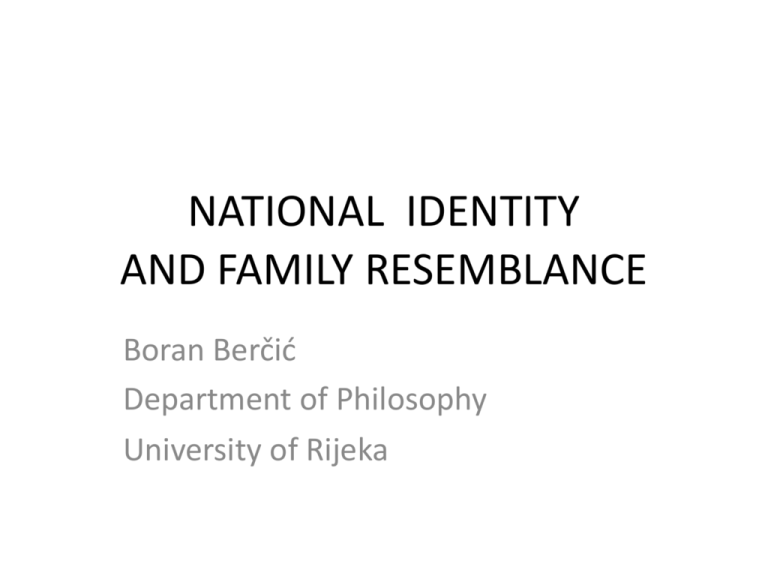
The Nationalism of Ideas A Deep Dive
The nationalism of ideas: It’s a phrase that might sound academic, but its impact reverberates through our daily lives, shaping political landscapes and cultural identities. This isn’t just about waving flags; it’s about the power of beliefs, the influence of shared narratives, and how those narratives can both unite and divide. We’ll explore how ideas become intertwined with national identity, examining historical movements and modern manifestations to understand this complex and often controversial force.
From the rise of specific ideologies to the role of intellectual elites, we’ll unpack the mechanisms that spread these nationalistic ideas across borders and cultures. We’ll also delve into the positive and negative consequences, looking at its impact on social cohesion, economic development, and international relations. Prepare to question your assumptions and challenge your understanding of what it means to be “nationalistic” in the 21st century.
Defining “Nationalism of Ideas”

Nationalism of ideas, a less frequently discussed form of nationalism compared to its ethnic or civic counterparts, centers on the belief in the inherent superiority and universality of a specific set of ideas, values, or ideologies, often associated with a particular nation or culture. It transcends purely ethnic or territorial boundaries, aiming to spread its influence globally, promoting its ideals as a model for other societies to emulate.
This form of nationalism has a rich historical context, often intertwined with the rise of specific philosophical, religious, or political movements.The core characteristic distinguishing nationalism of ideas from other types lies in its emphasis on the ideological component. Unlike ethnic nationalism, which focuses on shared ancestry, language, or culture, or civic nationalism, which emphasizes shared political values and citizenship, nationalism of ideas prioritizes the dissemination and adoption of a particular belief system.
This often manifests as a missionary zeal, striving to convert others to its perspective, viewing the spread of its ideas as a form of national advancement or even a moral imperative. It’s less about shared blood or soil and more about shared beliefs and aspirations.
Characteristics of Nationalism of Ideas
Nationalism of ideas is characterized by several key features. First, it involves a strong belief in the inherent superiority of a specific set of ideas, often presented as universally applicable and beneficial. Second, it actively seeks to propagate these ideas beyond national borders, aiming for global influence and adoption. Third, it often involves a sense of mission or destiny, portraying the spread of its ideas as a crucial step towards a better world.
Finally, it can be associated with both soft power methods, such as cultural exchange and intellectual influence, and harder power methods, such as political pressure or even military intervention, depending on the specific movement and context.
The nationalism of ideas often manifests in unexpected ways; we see it in the narratives we construct about national identity and economic strength. For example, the recent trend of american men are getting back to work is frequently framed as a resurgence of American grit and resilience, a powerful symbol bolstering a particular vision of national progress.
This narrative, however, overlooks the complexities of labor participation and subtly reinforces a specific, arguably nationalistic, ideology of work and masculinity.
Comparison with Cultural and Civic Nationalism
While nationalism of ideas shares some similarities with cultural and civic nationalism, crucial differences exist. Cultural nationalism emphasizes the preservation and promotion of a nation’s unique cultural heritage, while civic nationalism focuses on shared political values and institutions. Nationalism of ideas, however, goes beyond preserving existing culture or promoting civic duty; it seeks to export a specific set of ideas, often presented as a superior model for social and political organization.
It can overlap with cultural nationalism if the ideas promoted are deeply rooted in a nation’s culture, but its primary focus remains the global dissemination of those ideas, regardless of their cultural origins. Similarly, while it might share some common ground with civic nationalism in promoting certain values, nationalism of ideas is far more prescriptive and proselytizing in its approach.
The nationalism of ideas is a fascinating beast; it shapes how we perceive our own political narratives and those of others. It’ll be interesting to see how this plays out in Kamala Harris’s upcoming campaign, as she prepares for her first interview – check it out here: harris set for first campaign interview – and how her messaging navigates these complex currents of national identity and ideology.
Ultimately, the success of any campaign hinges on effectively communicating a vision that resonates with a nation’s sense of itself.
Examples of Nationalism of Ideas
Several historical and contemporary movements exemplify nationalism of ideas. The spread of Christianity during the Middle Ages and the subsequent colonial era is a prime example. The missionary zeal driving its expansion across continents clearly demonstrates the propagation of a specific set of religious beliefs, closely intertwined with the power structures of European nations. Similarly, the spread of Enlightenment ideals during the 18th and 19th centuries, particularly the concepts of liberty, equality, and fraternity, can be seen as a form of nationalism of ideas, originating in France and spreading across Europe and beyond.
In more contemporary times, the global influence of American liberal democracy, with its emphasis on individual rights and free markets, presents another case study, although its adoption and impact vary significantly across different contexts. The spread of communist ideology during the 20th century, fueled by the Soviet Union, offers a contrasting example, showcasing the potential for both ideological influence and geopolitical power dynamics to intertwine within nationalism of ideas.
The Impact of “Nationalism of Ideas” on Society
Nationalism of ideas, while potentially fostering a sense of shared purpose and identity, exerts a complex and multifaceted influence on society. Its impact extends beyond mere political boundaries, shaping social structures, economic trajectories, and international relations in profound ways. Understanding both its positive and negative consequences is crucial for navigating its complexities and mitigating potential harms.
Social Cohesion: Positive and Negative Effects
Nationalism of ideas can strengthen social cohesion by providing a unifying narrative and set of values. A shared belief system, centered around a particular ideology or set of principles, can foster a sense of collective identity and purpose, leading to increased social solidarity and cooperation. However, this same unifying narrative can also exclude and marginalize those who do not subscribe to the dominant ideology.
The imposition of a singular national identity can lead to social fragmentation and conflict, particularly within diverse societies. For example, the prioritization of a specific religious or ethnic identity as the defining characteristic of the nation can lead to the persecution and discrimination of minority groups. The resulting social unrest and instability can severely undermine social cohesion.
Economic Development and International Relations
The impact of nationalism of ideas on economic development is equally complex. A focus on national self-reliance and protectionism, often associated with certain forms of nationalism, can hinder international trade and cooperation, potentially slowing economic growth. Conversely, a shared commitment to certain economic principles, such as free markets or social welfare, can foster economic stability and development within a nation.
In terms of international relations, nationalism of ideas can lead to both cooperation and conflict. Shared ideological commitments can facilitate alliances and partnerships, while competing ideologies can fuel tensions and even outright hostility. The Cold War, for example, was largely shaped by the competing nationalisms of ideas represented by the capitalist West and the communist East.
Impact on Minority Groups and Cultural Diversity
Nationalism of ideas frequently poses significant challenges to minority groups and cultural diversity. The emphasis on a singular national identity often marginalizes or ignores the unique identities and cultural contributions of minority groups. This can lead to discrimination, prejudice, and even violence. The suppression of minority languages, traditions, and cultural practices is a common feature of many nationalist movements.
The consequences can be devastating, leading to the erosion of cultural diversity and the loss of valuable social and cultural capital. Examples abound throughout history, from the suppression of indigenous cultures in colonial settings to the persecution of religious and ethnic minorities in various nation-states.
The nationalism of ideas often limits the sharing of crucial scientific advancements, hindering global collaboration. But thankfully, the collaborative nature of projects like the one described in this article, artificial intelligence is helping improve climate models , demonstrates that international cooperation can overcome such barriers. Ultimately, addressing climate change, a global issue, requires transcending nationalistic viewpoints and embracing universally beneficial scientific progress.
Hypothetical Scenario: The Long-Term Effects of “Technonationalism”
Imagine a future dominated by “Technonationalism,” a nationalism of ideas centered on the belief that national technological superiority is paramount. This ideology prioritizes domestic technological development and control over global technological standards. Initially, this might lead to increased investment in research and development, fostering technological innovation within the nation. However, in the long term, this inward-looking approach could isolate the nation from global technological advancements, hindering its long-term competitiveness.
Furthermore, the prioritization of national technological dominance could lead to conflicts with other nations pursuing similar goals, potentially escalating into technological arms races or even military conflicts. The resulting global instability could severely disrupt international trade and cooperation, ultimately harming the nation’s economic prosperity and global standing. This scenario highlights the potential for a nationalism of ideas, even one focused on seemingly beneficial goals, to have unforeseen and negative consequences.
Counter-Narratives and Challenges to “Nationalism of Ideas”: The Nationalism Of Ideas

Nationalism of ideas, while presenting a compelling narrative of shared identity and purpose, often overlooks the complexities of human experience and the inherent diversity within societies. This has led to the emergence of powerful counter-narratives that challenge its core tenets and strive to promote more inclusive and equitable perspectives. These counter-narratives often focus on highlighting the limitations of a singular national identity and the dangers of excluding or marginalizing dissenting voices.The effectiveness of these counter-narratives varies greatly depending on context and the specific strategies employed.
Some approaches prioritize intellectual debate and the dissemination of alternative viewpoints through academic research, public discourse, and media engagement. Others focus on grassroots activism and community organizing, building coalitions across different groups and mobilizing collective action to challenge dominant narratives. The success of these strategies often hinges on their ability to resonate with broader audiences and effectively counter the persuasive power of nationalist ideologies.
Strategies for Challenging “Nationalism of Ideas”, The nationalism of ideas
Effective challenges to nationalism of ideas often involve a multifaceted approach. Academic research plays a vital role in exposing the flaws in nationalist arguments, providing empirical evidence to counter simplistic narratives and highlighting the historical and social complexities often ignored by proponents of such ideologies. Public intellectual engagement, through debates, lectures, and media appearances, can further disseminate these counter-narratives to wider audiences.
Grassroots movements, focusing on local communities and marginalized groups, offer a crucial bottom-up approach, building solidarity and empowering individuals to challenge dominant narratives from within. Finally, legal and political advocacy can be instrumental in challenging discriminatory policies and practices that stem from nationalism of ideas.
Promoting Inclusivity and Cross-Cultural Understanding
Promoting inclusivity and cross-cultural understanding requires a fundamental shift away from the homogenizing tendencies of nationalism of ideas. Educational reforms, focusing on critical thinking skills, diverse perspectives, and global citizenship, are essential in fostering empathy and understanding across different cultural groups. Multicultural policies, actively promoting the participation and representation of diverse communities in all aspects of society, are crucial in building a more inclusive and equitable society.
Furthermore, fostering dialogue and exchange between different cultural groups, through community events, intercultural programs, and international collaborations, can promote mutual respect and understanding. The success of these approaches hinges on their ability to create genuine opportunities for meaningful interaction and mutual learning, thereby challenging the exclusionary nature of nationalist ideologies.
Potential Solutions to Mitigate Negative Consequences
The negative consequences of nationalism of ideas can be mitigated through a range of strategies. These strategies require a concerted effort from various stakeholders, including governments, educational institutions, media organizations, and civil society groups.
- Promote critical thinking and media literacy: Equipping citizens with the skills to critically analyze information and identify biases in media representations is crucial in countering the manipulative tactics often employed by nationalist ideologies.
- Support diverse voices and perspectives: Actively promoting the representation of diverse voices and perspectives in media, education, and public discourse is essential in challenging the dominance of a singular national narrative.
- Strengthen international cooperation and exchange: Fostering collaboration and exchange between nations can help break down barriers and promote understanding across cultures.
- Invest in intercultural education and dialogue: Investing in programs that promote intercultural understanding and dialogue can help foster empathy and respect across different groups.
- Reform legal frameworks to combat discrimination: Strengthening legal frameworks to protect the rights of minorities and combat discrimination based on ethnicity, religion, or other factors is essential in creating a more just and equitable society.
Visual Representation of “Nationalism of Ideas”

A powerful visual representation of “nationalism of ideas” could take the form of a stylized tapestry or mural. This artwork would avoid overt nationalistic symbols like flags or coats of arms, instead focusing on the abstract concepts that underpin the ideology. The aim is to convey the unifying power of shared beliefs and values, while also subtly hinting at the potential for exclusion and division.The composition would be complex and layered, reflecting the multifaceted nature of the phenomenon.
At its center, a vibrant, radiating core could depict a shared intellectual or cultural heritage – perhaps represented by interwoven threads of different colors, each representing a distinct element of national identity (literature, philosophy, art, etc.). These threads would intertwine and blend, symbolizing the synthesis of ideas that forms the basis of this type of nationalism. The colors used would be rich and varied, but with a noticeable harmony, reflecting the diversity within the unifying ideology.
Symbolic Elements and Compositional Choices
The radiating core of shared heritage would gradually fade into a less defined periphery, where the threads become more separated and less distinct. This outer area would represent the potential for exclusion – those who do not share the core beliefs and values are marginalized, left outside the vibrant center. The contrast between the vibrant core and the muted periphery would be striking, visually demonstrating the potential for both inclusivity and exclusion inherent in nationalism of ideas.
The overall style would lean towards a blend of abstract expressionism and symbolic realism, allowing for both emotional impact and clear symbolic representation.
Promoting and Critiquing “Nationalism of Ideas” through Visual Representation
This visual representation could be used to promote “nationalism of ideas” by emphasizing the unifying power of shared cultural heritage and intellectual traditions. Proponents could highlight the vibrant core, showcasing the beauty and richness of a shared national identity, inspiring a sense of collective pride and belonging. The potential for exclusion could be downplayed or ignored, focusing instead on the positive aspects of shared values and beliefs.Conversely, critics could use the same image to expose the dangers of such nationalism.
They could emphasize the periphery, highlighting the marginalization and exclusion of those who don’t conform to the dominant ideology. The fading threads and muted colors would represent the silencing of dissenting voices and the suppression of diverse perspectives. The contrast between the vibrant center and the muted periphery would serve as a stark visual metaphor for the inherent inequalities and divisions fostered by “nationalism of ideas.” The image’s ambiguity allows for multiple interpretations, making it a powerful tool for both promotion and critique, depending on the context and framing.
Ultimately, understanding the nationalism of ideas requires a nuanced approach. It’s not simply a matter of good versus evil, but a complex interplay of historical context, cultural values, and political maneuvering. While it can foster a sense of unity and shared purpose, it can also lead to exclusion, conflict, and the suppression of dissenting voices. By examining its various manifestations and consequences, we can better navigate the challenges it presents and strive for a more inclusive and understanding world.
The journey of exploring this topic is a crucial step in fostering informed discussion and promoting global citizenship.




